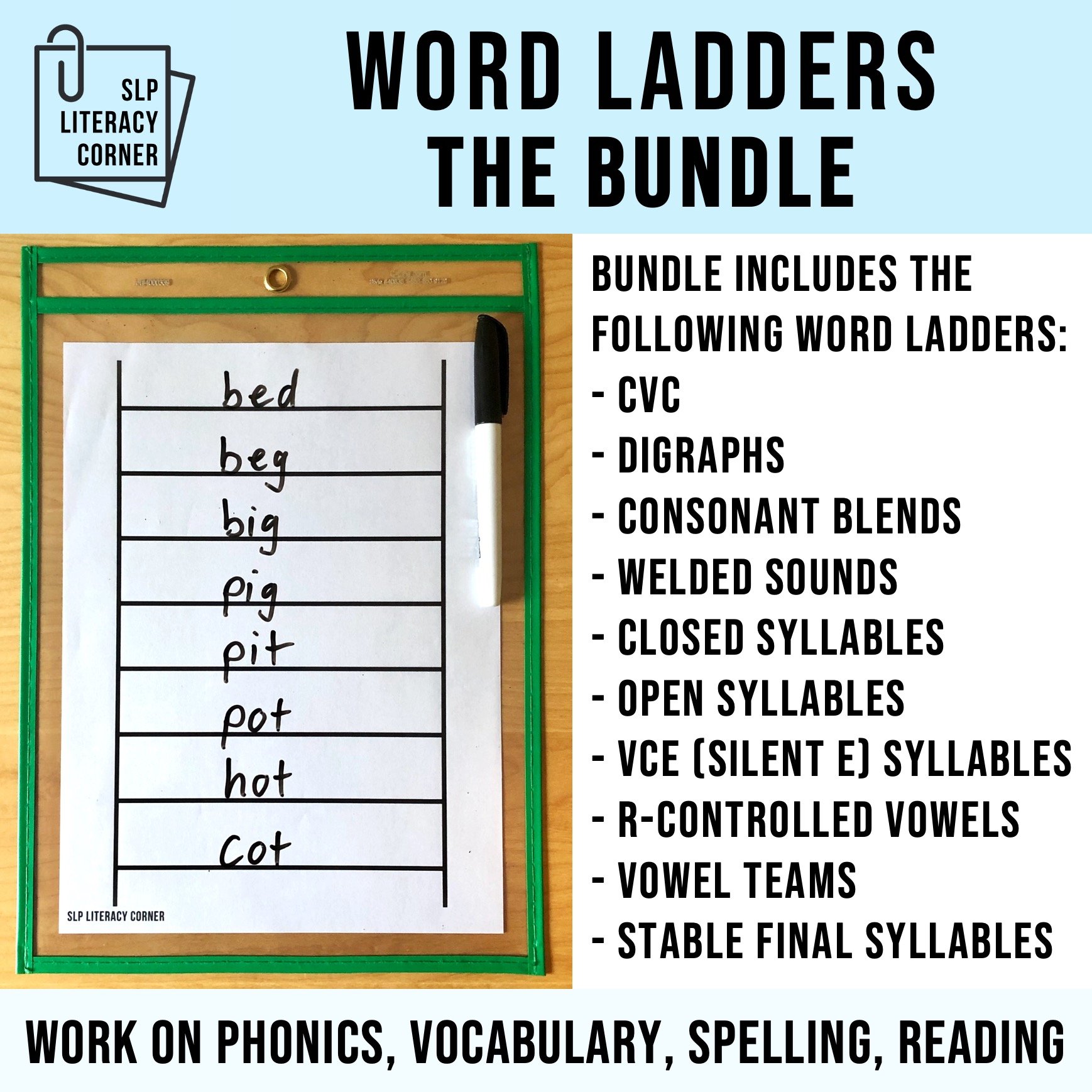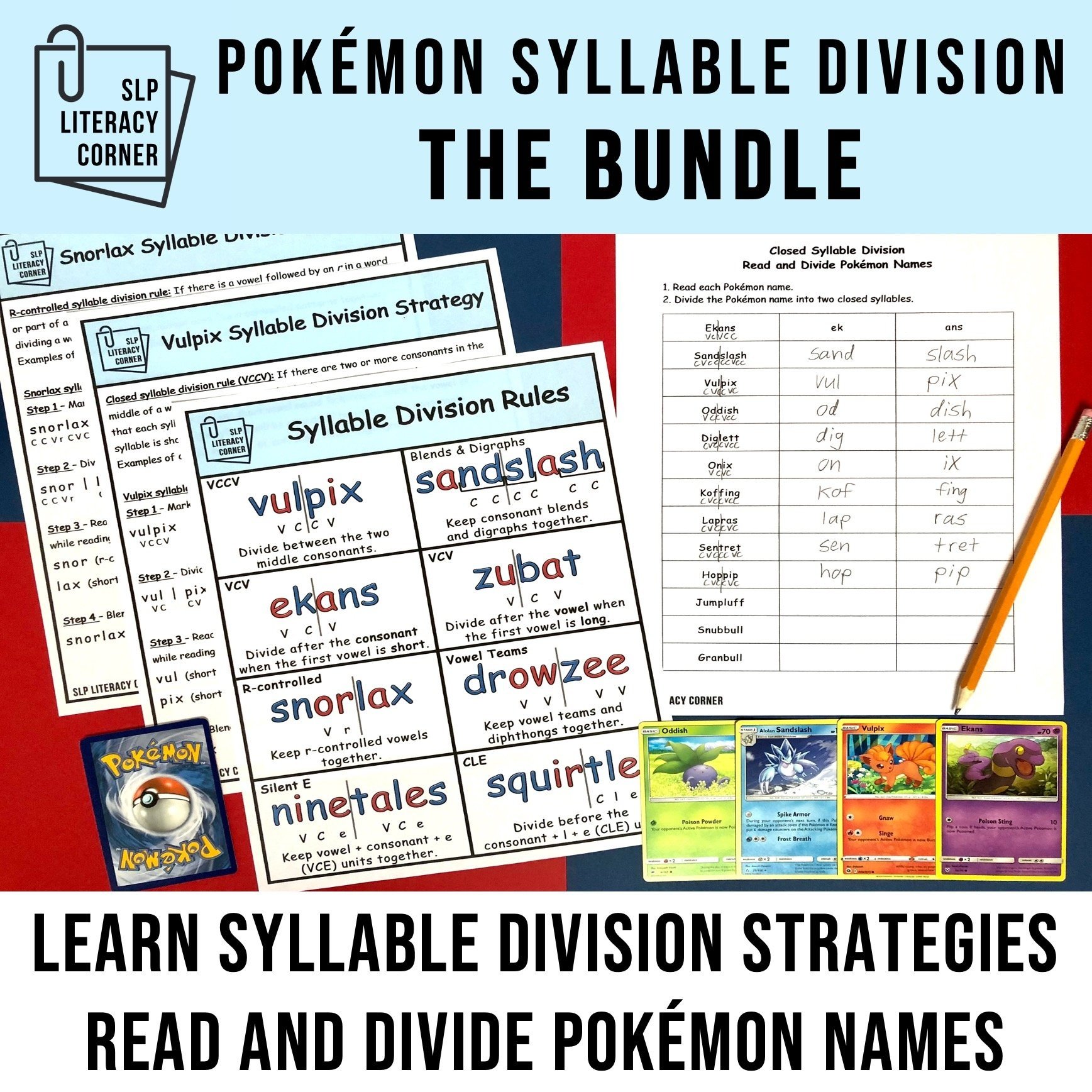Syllable Types
Written by: Brianna Guild, MHSc SLP(C)
Date: April 5, 2023
Updated: August 29, 2024
A syllable is a word or part of a word with one vowel sound. According to the International Dyslexia Association (IDA), structured literacy instruction should systematically and explicitly teach the 6 main syllable types in English:
1. Closed Syllables
Syllables closed off by one or more consonant letters. The vowel sound is generally short.
- Examples: cat, ship, bled, stick, huff, watch, judge
2. Open Syllables
Syllables that end with a vowel. The vowel sound is generally long.
- Examples: she, hi, go, flu, cry
3. VCE Syllables
Syllables containing a vowel (V), followed by a single consonant (C), and a silent e. While the e is silent, the other vowel generally represents a long vowel sound. They are also known as "magic e" or "silent e" syllables. Silent e also has other jobs (9 to be exact), which we can discuss another day.
- Examples: cave, these, bike, nose, flute
4. R-controlled Syllables
Syllables containing a vowel followed by the letter r, which changes the vowel sound. They are also known as "bossy r" or "r-influenced" syllables.
- Examples: cart, horn, fern, bird, turn
5. Vowel Team Syllables
Syllables containing a group of 2 or more vowels that represent a long, short, or diphthong (gliding) vowel sound. It is also important to know that one vowel team may make multiple sounds (e.g., ea can represent long a, long e, or short e sounds).
- Long vowel sound examples: rain, stay, steak, mean, key, pie, night, boat, glue
- Short vowel sound examples: bread, deaf
- Diphthong sound examples: coin, boy, plow, cloud
6. Stable Final Syllables
Syllables ending in a consonant + l + e. When combined with an open syllable, there is no double consonant (e.g., title). When combined with a closed syllable, there is a double consonant (e.g., little). They are also known as "CLE" syllables since they are composed of a consonant, and the letters l and e.
- Initial open syllable examples: maple, ladle, stifle, idle
- Initial closed syllable examples: apple, puzzle, riddle, snuggle
- Other stable final patterns include: -tion, -sion, -sure, -ture
What is the best phonics scope and sequence to use?
- There is no one correct scope and sequence for phonics instruction.
- In print-to-speech approaches, instruction typically progresses from easier and more common spellings, like closed syllables and short vowel sounds, to more challenging or less common spellings, like stable final syllables.
- In speech-to-print or structured linguistic literacy (SLL) approaches, instruction moves from the basic code, where one letter represents one sound, to the advanced code, where multiple letters are used to represent one sound.
- Overall, all structured literacy approaches and programs should progress from simpler and more common spelling patterns to more advanced and/or less common patterns, and include ongoing review of taught patterns.
Should we teach syllable types and syllable division strategies?
- The current body of research has not yet provided conclusive evidence for whether or not we should teach syllable types and specific syllable division strategies (e.g., VC|CV, V|CV, VC|V patterns).
- Some arguments for teaching syllable types: knowledge of syllable types can help with reading and spelling longer words, understanding spelling conventions such as doubling of consonant letters (little vs. title), and providing an organizational system for spelling patterns.
- Some arguments against teaching syllable types: syllable types are not consistent (e.g., do not account for the schwa vowel sound), can take a long time to teach, may cause cognitive overload for students, and may be unnecessary when students are taught flexible syllable division strategies.
What are more flexible syllable division strategies?
Here are 3 strategies that have been studied and proven successful to help students read multisyllabic words:
- Rather than teaching many specific syllable division strategies, teach students to take words apart using the reliable rule that every syllable has at least one vowel.
- Teach students to use their oral language knowledge, including understanding about other sounds vowels make, to sound out an unknown word. This includes “flexing” vowel sounds and adjusting syllable stress and schwa (unstressed vowel sound), known as set for variability or mispronunciation correction.
- Teach students to identify the morphological units of longer words, including the root or base word, affixes, and inflectional endings. Then, use these meaningful units to decode the word and determine the meaning of the word.
Join the SLP Literacy Corner email newsletter to get access to exclusive free resources, such as handouts with activity ideas for 5 components of literacy and a syllable types flow chart. Sign up here!
If you use syllable type activities, check these out:
References:
Chahbazi, N. (2022, January). Phonics and Syllable Rules: Do We Need Them? Evidence-Based Literacy Instruction (EBLI). https://eblireads.com/phonics-and-syllable-rules-do-we-need-them/
Blevins, W. (2016). A Fresh Look at Phonics: Common Causes of Failure and 7 Ingredients for Success. Corwin Press Inc.
International Dyslexia Association Ontario. (2020). Structured Literacy: Effective Instruction for Students with Dyslexia and Related Reading Difficulties. https://dyslexiaida.org/structured-literacy-effective-instruction-for-students-with-dyslexia-and-related-reading-difficulties/
Moats, L. & Tolman C. (n.d.). Six Syllable Types. Reading Rockets. https://www.readingrockets.org/article/six-syllable-types
Pierson, J. M. (2020). Syllable Division: New Data that Can Inform Intervention. Dyslexia Help at the University of Michigan. https://dyslexiahelp.umich.edu/answers/ask-dr-pierson/syllable-division-new-data-can-inform-intervention






